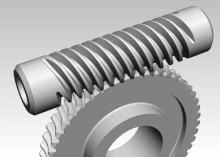
A | B | C | D | E | F | G | H | CH | I | J | K | L | M | N | O | P | Q | R | S | T | U | V | W | X | Y | Z | 0 | 1 | 2 | 3 | 4 | 5 | 6 | 7 | 8 | 9

| Part of a series on |
| Classical mechanics |
|---|
Rotation around a fixed axis or axial rotation is a special case of rotational motion around an axis of rotation fixed, stationary, or static in three-dimensional space. This type of motion excludes the possibility of the instantaneous axis of rotation changing its orientation and cannot describe such phenomena as wobbling or precession. According to Euler's rotation theorem, simultaneous rotation along a number of stationary axes at the same time is impossible; if two rotations are forced at the same time, a new axis of rotation will result.
This concept assumes that the rotation is also stable, such that no torque is required to keep it going. The kinematics and dynamics of rotation around a fixed axis of a rigid body are mathematically much simpler than those for free rotation of a rigid body; they are entirely analogous to those of linear motion along a single fixed direction, which is not true for free rotation of a rigid body. The expressions for the kinetic energy of the object, and for the forces on the parts of the object, are also simpler for rotation around a fixed axis, than for general rotational motion. For these reasons, rotation around a fixed axis is typically taught in introductory physics courses after students have mastered linear motion; the full generality of rotational motion is not usually taught in introductory physics classes.
Translation and rotation

A rigid body is an object of a finite extent in which all the distances between the component particles are constant. No truly rigid body exists; external forces can deform any solid. For our purposes, then, a rigid body is a solid which requires large forces to deform it appreciably.
A change in the position of a particle in three-dimensional space can be completely specified by three coordinates. A change in the position of a rigid body is more complicated to describe. It can be regarded as a combination of two distinct types of motion: translational motion and circular motion.
Purely translational motion occurs when every particle of the body has the same instantaneous velocity as every other particle; then the path traced out by any particle is exactly parallel to the path traced out by every other particle in the body. Under translational motion, the change in the position of a rigid body is specified completely by three coordinates such as x, y, and z giving the displacement of any point, such as the center of mass, fixed to the rigid body.
Purely rotational motion occurs if every particle in the body moves in a circle about a single line. This line is called the axis of rotation. Then the radius vectors from the axis to all particles undergo the same angular displacement at the same time. The axis of rotation need not go through the body. In general, any rotation can be specified completely by the three angular displacements with respect to the rectangular-coordinate axes x, y, and z. Any change in the position of the rigid body is thus completely described by three translational and three rotational coordinates.
Any displacement of a rigid body may be arrived at by first subjecting the body to a displacement followed by a rotation, or conversely, to a rotation followed by a displacement. We already know that for any collection of particles—whether at rest with respect to one another, as in a rigid body, or in relative motion, like the exploding fragments of a shell, the acceleration of the center of mass is given by
Kinematics
Angular displacement
Given a particle that moves along the circumference of a circle of radius , having moved an arc length , its angular position is relative to its initial position, where .
In mathematics and physics it is conventional to treat the radian, a unit of plane angle, as 1, often omitting it. Units are converted as follows:
An angular displacement is a change in angular position:
Angular velocity
Change in angular displacement per unit time is called angular velocity with direction along the axis of rotation. The symbol for angular velocity is and the units are typically rad s−1. Angular speed is the magnitude of angular velocity.
The instantaneous angular velocity is given by
Using the formula for angular position and letting , we have also
where is the translational speed of the particle.Angular velocity and frequency are related by
Angular acceleration
A changing angular velocity indicates the presence of an angular acceleration in rigid body, typically measured in rad s−2. The average angular acceleration over a time interval Δt is given by
The instantaneous acceleration α(t) is given by
Thus, the angular acceleration is the rate of change of the angular velocity, just as acceleration is the rate of change of velocity.
The translational acceleration of a point on the object rotating is given by
The radial acceleration (perpendicular to direction of motion) is given by
Antropológia
Aplikované vedy
Bibliometria
Dejiny vedy
Encyklopédie
Filozofia vedy
Forenzné vedy
Humanitné vedy
Knižničná veda
Kryogenika
Kryptológia
Kulturológia
Literárna veda
Medzidisciplinárne oblasti
Metódy kvantitatívnej analýzy
Metavedy
Metodika
Text je dostupný za podmienok Creative
Commons Attribution/Share-Alike License 3.0 Unported; prípadne za ďalších
podmienok.
Podrobnejšie informácie nájdete na stránke Podmienky
použitia.
www.astronomia.sk | www.biologia.sk | www.botanika.sk | www.dejiny.sk | www.economy.sk | www.elektrotechnika.sk | www.estetika.sk | www.farmakologia.sk | www.filozofia.sk | Fyzika | www.futurologia.sk | www.genetika.sk | www.chemia.sk | www.lingvistika.sk | www.politologia.sk | www.psychologia.sk | www.sexuologia.sk | www.sociologia.sk | www.veda.sk I www.zoologia.sk






















